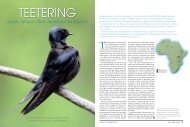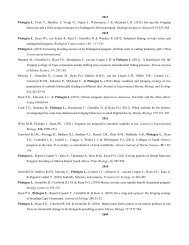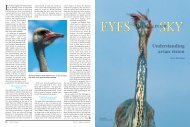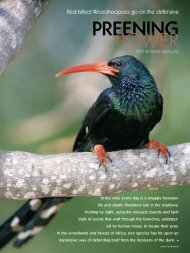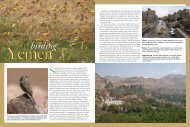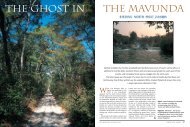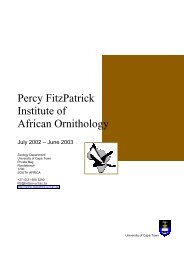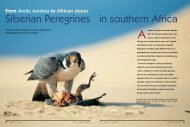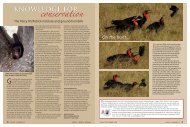Best buy spotting scopes
Best buy spotting scopes
Best buy spotting scopes
You also want an ePaper? Increase the reach of your titles
YUMPU automatically turns print PDFs into web optimized ePapers that Google loves.
<strong>Best</strong> <strong>buy</strong><br />
<strong>spotting</strong> <strong>scopes</strong><br />
Using a good <strong>spotting</strong> scope is one of the best ways to enhance your enjoyment of<br />
watching birds, and to improve your birding ability. Binoculars remain the primary tool<br />
in most birding situations, but the advent of small, compact <strong>spotting</strong> <strong>scopes</strong> now allows<br />
unrivalled views of birds. Thanks to digital cameras, these images can even be captured by<br />
digiscoping, which is great for documenting rarities. The growing popularity of <strong>scopes</strong> has<br />
spawned a diversity of models in a wide range of prices.<br />
Peter Ryan and a panel of birders report on a cross-section of the market.<br />
product images: alex bozas<br />
Birding is dependent on<br />
technology. Just as binoculars<br />
were essential<br />
for the advent of birding<br />
in the 1930s, so<br />
tele<strong>scopes</strong><br />
kowa tsn 883 prominar<br />
december 2007/january 2008<br />
revolutionised bird identification in<br />
the 1970s. The ability to see distant<br />
birds at close quarters allowed birders<br />
to appreciate many of the fine details<br />
that help to separate some of the trickier<br />
groups of species. Early tele<strong>scopes</strong> were<br />
long, unwieldy objects, which largely<br />
confined their use to static pursuits<br />
and the observation of faraway<br />
birds, such<br />
as waders and seabirds.<br />
The hardy<br />
souls who pioneered<br />
sea-watching were<br />
considered distinctly<br />
User’s gUide<br />
odd, not only because of their antisocial<br />
habits, but because they endured<br />
long hours lying on their backs, propping<br />
up their tele<strong>scopes</strong> with their feet!<br />
Fortunately, optical companies saw the<br />
need for more compact designs, and the<br />
use of prisms has largely done away with<br />
the long, telescoping tube. At the same<br />
time, advances in lens technology have<br />
improved image quality even at high<br />
magnification. Modern <strong>spotting</strong> <strong>scopes</strong><br />
are reasonably small, compact devices<br />
that can be used in all habitats and<br />
deliver high-quality images up to 60x<br />
magnification.<br />
<br />
<strong>scopes</strong><br />
peter ryan<br />
55
User’s gUide to <strong>scopes</strong><br />
Africa – Birds & Birding’s call for<br />
review models from suppliers in South<br />
Africa yielded 22 tele<strong>scopes</strong>. They were<br />
assessed in much the same way as<br />
were the binoculars reported on in<br />
the December 2006/January 2007 issue,<br />
with scores for optical performance<br />
and ‘feel’ (ease of use, robustness and<br />
appearance). These two categories were<br />
broken down into a number of specific<br />
attributes and scored from 1 to 5.<br />
Optical quality was rated on brightness,<br />
colour rendition, chromatic aberration,<br />
flare when looking into the light, width<br />
of the field of view, depth of field,<br />
close-focus distance, the speed of focus<br />
action, whether the focus was crisp,<br />
and whether the image was flat and<br />
sharp across the entire field of view.<br />
Feel was scored on balance, weight, size,<br />
aesthetic appeal, apparent robustness,<br />
whether the focus mechanism<br />
was easy to reach and use,<br />
and whether the eye-cup<br />
was comfortable<br />
and suitable<br />
for use<br />
leica apo televid 62<br />
with glasses. We also noted whether<br />
the manufacturer claimed the scope<br />
was waterproof, but didn’t put<br />
this to the test.<br />
The assessment<br />
was done without<br />
knowing<br />
the price of the<br />
various models<br />
being reviewed.<br />
Scores were simply<br />
averaged across all<br />
panel members to give a rating from 1 to<br />
5 for optics and feel. The combined score<br />
was then compared to the cost to derive<br />
an index of value for money. The results<br />
are summarised in the table on page 58.<br />
We had 20 conventional tele<strong>scopes</strong><br />
to review and two compact<br />
models that were really<br />
high-powered monoculars. The latter<br />
two, both by Leupold, scored well for<br />
their compact design, but were a little<br />
restricted in terms of field of view.<br />
Of the two, the 15–30x zoom was the<br />
only model that warrants the title of a<br />
scope, but it couldn’t really hold its own<br />
with a full-size model in terms of<br />
image size. Another ‘odd’<br />
model was the 25–75x<br />
mirror reflector from<br />
UltraOptec. There are<br />
some very good reflector<br />
<strong>scopes</strong> available (at a<br />
price), but this is not one<br />
try before you <strong>buy</strong> When <strong>buy</strong>ing a scope, check the following points.<br />
3 How does it feel? try it on a tripod. simulate viewing and focusing<br />
at a range of angles.<br />
3 is the tripod attachment point at the scope’s centre of gravity,<br />
so that the scope is balanced on the tripod?<br />
3 is the focus wheel accessible? (This is especially important if you<br />
are left-handed.)<br />
3 is the close-focus distance 6 metres or less?<br />
3 How fast is the focus? (You shouldn’t have to have to turn the focus<br />
wheel more than five times to track from infinity to closest focus.)<br />
3 How does the eye-cup feel? is it likely to perish? (For example, is<br />
it made of soft rubber?)<br />
3 is the field of view adequate? if you find the view restricted, try<br />
a fixed-magnification, wide-angle eyepiece.<br />
3 is the image nice and bright and are the colours true to life? does<br />
this change markedly as you zoom in using a zoom eyepiece?<br />
3 is there excessive chromatic aberration? (Look for ghostly blue<br />
or yellow edges to objects when viewed towards the edge of the<br />
field of view.)<br />
nikon ra iii 82 wp<br />
of them. Its low price may be attractive,<br />
but its image quality certainly is not.<br />
All the conventional <strong>scopes</strong> were<br />
equipped with zoom lenses (usually<br />
20–60x, but 15–45x or 16–48x in<br />
some of the smaller models). Fixedmagnification<br />
wide-angle eyepieces<br />
were supplied for only a few <strong>scopes</strong>,<br />
despite their inherent advantages. In<br />
each case, where both eyepieces were<br />
available, the fixed-magnification lens<br />
scored roughly half a point higher<br />
for optical performance. We strongly<br />
encourage potential <strong>buy</strong>ers to consider<br />
a fixed-magnification eyepiece, especially<br />
if you are going to be digiscoping.<br />
For this review, however, we compared<br />
models using their zoom lenses.<br />
Unlike binoculars, the relationship<br />
between cost and quality is roughly<br />
linear for tele<strong>scopes</strong>, so you really do get<br />
what you pay for. The panel was unanimous<br />
in discriminating three categories<br />
of <strong>scopes</strong>.<br />
3 is the focus sharp across the field of view, or does it soften<br />
towards the edges?<br />
3 is the image flat? (try panning quickly and look for bulging in<br />
the central portion of the image.)<br />
3 is there a problem with flare? take the scope outside and look<br />
towards the sun (not at it – that can seriously damage your eyes!);<br />
does the image get washed out by ghostly internal reflections?<br />
3 does the slip-out sun-shield for the objective lens stay in place?<br />
3 is it robust? if armour- or rubber-coated, is this securely<br />
attached to the body?<br />
3 are both the body and eyepiece waterproof? is there any guarantee<br />
if they leak?<br />
3 is the body of the scope nitrogen-filled? (This ensures it is<br />
sealed, and prevents internal fogging or problems with fungal<br />
growth on the lenses.)<br />
3 are the lens covers practical? (caps that screw on often slow the<br />
action; having the option of tying the eyepiece cover onto the<br />
scope is nice, especially for <strong>scopes</strong> with angled eyepieces.)<br />
The cReam of The cRoP<br />
At the top of the list, with aggregate<br />
scores of 4 or more, were <strong>scopes</strong> from<br />
the usual premium suppliers: Kowa,<br />
Leica, Swarovski and Zeiss. Optically,<br />
the huge fluorite lens of the Kowa TSN<br />
883 marginally shaded the opposition,<br />
but the difference between it and<br />
the Swarovski ATS 80 was minimal,<br />
despite the fact that the top-of-therange<br />
HD Swarovski was not submitted<br />
for review. Overall, the Swarovski came<br />
out top, thanks to its smaller size and<br />
lower weight, but there wasn’t much in<br />
it. Both the Leica Televid 77 and Zeiss<br />
Diascope 85 were optically superb, but<br />
the Leica suffered from a slightly smaller<br />
field of view and excessive weight,<br />
whereas the Zeiss was let down by the<br />
slow operation and poor ergonomics<br />
of its focus mechanism. All the <strong>scopes</strong><br />
in this group are pricey, ranging from<br />
R19 000 to R29 000. If you have that<br />
much to spend, the Swarovski probably<br />
offers best value for money.<br />
a good comPRomise<br />
If your budget is a bit smaller, several<br />
<strong>scopes</strong> from Kowa and Nikon scored<br />
3 to 3.5 points overall for a more<br />
affordable R7 000 to R12 000. The least<br />
attractive of these is the rather large,<br />
bulky and somewhat optically inferior<br />
Kowa TSN 821. So it comes down to a<br />
choice between the bottom-end Kowas<br />
and the two Nikon models. I didn’t particularly<br />
like the Nikon zoom eyepiece<br />
(the zoom action was awkward, and it<br />
lost a little optically at mid-zoom), but<br />
I suspect that the Nikon would be very<br />
competitive with a fixed-magnification<br />
lens. Both small Kowas provided fine<br />
images, but they felt decidedly less<br />
robust than their bigger siblings, and<br />
only the body is listed as waterproof,<br />
not the eyepieces. Bushnell weren’t able<br />
to supply an Elite to test. I like to think<br />
it would also compete in this category,<br />
but at R11 500 it would have to do well<br />
to surpass the Nikons and small Kowas<br />
in value for money.<br />
The besT of The ResT<br />
The rest of the models on offer all had<br />
aggregate scores of less than 3. The<br />
best of the bunch were the Kamakuras,<br />
which were optically quite good, but<br />
fell away a little in terms of finish and<br />
handling. The Bushnell Legend and<br />
steady as she goes mounting your scope<br />
the high magnification of <strong>scopes</strong> also exaggerates any small movements or vibrations.<br />
Surprisingly, no <strong>scopes</strong> reviewed had image-stabilisation (IS), despite its success<br />
in long telephoto lenses, and its gradual penetration into the binocular market. It is<br />
surely only a matter of time before IS technology becomes a standard option on <strong>scopes</strong>.<br />
Until then, you have to seat a scope securely to get a stable image, ideally on a tripod or<br />
window mount. You can use a bean bag, but this is not good for following moving birds.<br />
The image quality, and ultimately your enjoyment of your scope, depends on having a<br />
steady support, yet it’s amazing how often you see people using good <strong>scopes</strong> on inferior<br />
tripods. A mount has two components: a head that allows smooth tracking (video heads<br />
are best), and a steady support (tripod or window mount). Coupled with this, you want<br />
something that is not too heavy and is easy to use. Get one with quick-locking leg sections<br />
(screwing locks closed is time consuming and can cost you a bird), and check that you are<br />
happy with the head controls, especially if you are left-handed.<br />
We were offered seven tripods for review: Manfrotto 700 RC2 – 190V kit, Slik 504 QF II,<br />
Swarovski CT 101, Velbon CF 530 Sherpa Pro, Carl Zeiss Stativ, and two no-name models<br />
from the suppliers of UltraOptec <strong>scopes</strong> – one rather flimsy aluminium<br />
tripod that was nice and light, but couldn’t support a scope adequately<br />
in any sort of a wind, and one<br />
swarovski ats 80<br />
very sturdy model which used the same<br />
quick-release head as a Manfrotto, and<br />
provided a similar quality of support, but<br />
was appreciably heavier.<br />
Like the <strong>scopes</strong> themselves, these<br />
tripods ranged substantially in price, and<br />
there was a strong correlation between quality and<br />
cost. Most birders are likely to go for a Manfrotto<br />
(R2 000) or Slik (R1 300), both of which offer good,<br />
solid tripods with smooth-turning heads. The<br />
larger, no-name model from UltraOptec (Tripod<br />
FT6307) cost only slightly less than the Slik, but<br />
weighed a third more and isn’t the kind of<br />
tripod you’d want to carry too far in the field.<br />
The Zeiss Stativ is similar to the Manfrotto,<br />
but is also heavier.<br />
At the top end of the market are tripods<br />
with carbon-fibre legs that reduce weight<br />
without compromising stability. This<br />
freedom comes at a price, however.<br />
The Velbon CF 530 Sherpa Pro (2 kg)<br />
is about R4 000 (depending on the<br />
swarovski ct 101<br />
head choice) and the Swarovski CT<br />
101 (2.1 kg) is R4 750.<br />
Tasco had slow focusing mechanisms,<br />
as well as poor close-focus distances.<br />
The most disappointing scope optically<br />
(apart from the UltraOptec mirror), was<br />
the Leupold Sequoia. Perhaps we got a<br />
defective model, because I have come<br />
to expect better from this company.<br />
In terms of value for money, most of<br />
the <strong>scopes</strong> in the group were not much<br />
cheaper than the Nikons and small<br />
Kowas. I would consider the Tasco as a<br />
cheap, entry-level scope at R3 000 only<br />
if I were on a really tight budget.<br />
We tried to reduce subjective elements<br />
in the review process, but within each<br />
category, it comes down to personal<br />
taste between closely matched models.<br />
There’s no substitute for checking out<br />
a model in person before you take the<br />
plunge. Happy shopping!<br />
<br />
56 <strong>scopes</strong> africa – birds & birding<br />
december 2007/january 2008 <strong>scopes</strong> 57
User’s gUide to <strong>scopes</strong><br />
model<br />
magnifi-<br />
cation<br />
optics feel value cost (r)* mass<br />
(kg)<br />
close<br />
focus (m)<br />
focus<br />
turns<br />
Swarovski ATS 80 20–60x80 HHHHI HHHHI HHHHI 20 000 1.6 5 2 yes<br />
Kowa TSN 883 Prominar 20–60x88 HHHHI HHHHI HH 29 500 1.85 5 1.8 yes<br />
Leica Televid 77 20–60x77 HHHHI HHHH HHHI 19 100 2.1 4 4 yes<br />
Carl Zeiss Diascope 85 T*FL 20–60x85 HHHHI HHHH HHHI 19 400 1.8 4.5 5.5 yes<br />
Leica APO Televid 62 16–48x62 HHHH HHHH HHH 20 300 1.4 3.5 4.5 yes<br />
Kowa TSN 771 20–60x77 HHHH HHHH HHI 19 100 1.65 5 1.3 yes<br />
Kowa TSN 661 20–60x66 HHHI HHHI HHHI 8 900 1.25 6 5 body<br />
Nikon RA III 65 WP 16–48x65 HHHI HHHI HHHH 7 000 1.15 4 3.5 yes<br />
Kowa TSN 601 20–60x60 HHHI HHHI HHH 7 800 1 6 5 body<br />
Nikon RA III 82 WP 20–60x82 HHHI HHHI HH 9 000 1.45 6 3.5 yes<br />
Kowa TSN 821M 20–60x82 HHHI HHH H 12 000 1.7 6 5 body<br />
Kamakura SP 66 ED 20–50x66 HHH HHH HH 6 200 1.5 5 6.5 yes<br />
Kamakura SP 80 ED 20–60x80 HHH HHH H 9 000 1.7 6 6.5 yes<br />
Bushnell Legend 20–60x80 HHH HHH H 7 000 1.6 10 10 yes<br />
Tasco 20–60x80 HHI HHI HHHI 3 000 1.2 6 15 yes<br />
Leupold Sequoia 20–60x80 HHI HHI H 5 600 1.8 8 4 yes<br />
*The prices shown in this table were correct as at the end of August 2007 – they are intended as a guide only and we cannot take into account<br />
import currency fluctuations and retail price increases.<br />
waterproof<br />
Kenko Pro Field 80A 20–60x80 HHI HHI HI 4 700 1.4 6 5 shower<br />
UltraOptec WSG 20–60x90 HHI HHI H 4 100 1.45 14 8 ?<br />
Bushnell Spacemaster 20–60x60 HH HHI H 4 000 1 8 1.5 ?yes<br />
UltraOptec WFT mirror 25–75x70 HI HHI HH 1 725 0.75 5 8 ?no<br />
Leupold Gold Ring 15-30 15–30x50 HHH HHH HHH 4 800 0.6 4.5 0.5 yes<br />
Leupold Gold Ring 10-20 10–20x40 HHH HHH HHI 3 750 0.45 2.5 0.5 yes<br />
Scores (1–5) for the 22 <strong>scopes</strong> tested, in descending order of overall performance.<br />
model Make and model number<br />
magnification Zoom range and objective lens diameter<br />
optics 1–5 stars for optical quality<br />
feel 1–5 stars for feel, handling and robustness<br />
value 1–5 stars for value for money<br />
cost Recommended retail price (incl. VAT) for body and zoom eyepiece<br />
mass Approximate mass in kilograms<br />
close focus Closest focus distance (metres)<br />
focus turns Number of turns from closest focus to infinity<br />
waterproof Yes or no<br />
iT WeNT ThaT WaY…<br />
Finding your bird<br />
Because of the higher magnification, the<br />
field of view of a scope is appreciably<br />
narrower than that of a pair of binoculars.<br />
Even at 20x, a typical scope sees less<br />
than one third of the area of a decent<br />
pair of binoculars, and by the time you<br />
get to 60x, this has dwindled to less<br />
than one sixth. The narrow field of view<br />
makes finding what you want to see a little<br />
tricky. Some <strong>scopes</strong> offer sighting aids,<br />
ranging from subtle grooves and small<br />
tubes to optical devices that clip onto<br />
the scope. (Nikon has one that makes<br />
their otherwise fairly elegant <strong>scopes</strong> look<br />
like a lopsided Starship Enterprise –<br />
fortunately it is only an option!) Such<br />
devices aren’t really necessary and can<br />
be a liability, especially if you are trying<br />
to find a moving bird. Just as locating a<br />
bird using binoculars becomes second<br />
nature with practice, so can tracking one<br />
in your scope.<br />
eYePieces<br />
• straight or offset?<br />
Early tele<strong>scopes</strong> were long tubes, with the<br />
eyepiece in line with the viewing direction.<br />
However, the use of prism arrays<br />
to make <strong>scopes</strong> more compact<br />
also allows for the eye-<br />
piece to be angled<br />
relative to the<br />
v i e w i n g<br />
Bushnell spacemaster<br />
direction. Most models are available with<br />
either straight or offset eyepieces.<br />
Which should you choose? Bushnell’s<br />
Spacemaster avoids this dilemma by<br />
offering a variable offset from 0–90°. We<br />
were concerned about dust/moisture<br />
penetration through the RoboCop-type<br />
sliding plates (although Bushnell claims<br />
it is fully waterproof).<br />
At first, having an offset eyepiece may<br />
seem to exacerbate the problem of finding<br />
what you’re looking for through the<br />
scope, but you soon get used to it. The<br />
main advantage is a more comfortable<br />
viewing angle, especially when tracking<br />
birds flying overhead or in the forest<br />
canopy. Offset eyepieces also make<br />
it much easier for people of different<br />
heights to use the same scope, and allow<br />
a lower tripod height (with concomitant<br />
reduced vibration). These days, most<br />
birders opt for angled eyepieces.<br />
• Zoom or wide-angle?<br />
Unlike binoculars, most <strong>scopes</strong> come<br />
with a variety of eyepieces, offering a<br />
range of magnification options. Many<br />
birders favour a zoom, because of its<br />
greater flexibility, but you do pay a<br />
price in terms of field of view and image<br />
quality (and it costs more too). The loss<br />
of quality is relatively minor in top-ofthe-range<br />
<strong>scopes</strong>, but the smaller field<br />
of view is quite marked. After using a<br />
25x or 30x wide-angle eyepiece, reverting<br />
to a zoom is quite claustrophobic.<br />
With the luxury of having both to<br />
choose from, I find that I very seldom<br />
bother to use the zoom.<br />
The larger image size of a<br />
fixed wide-angle also makes<br />
it easier to capture good digiscope<br />
images.<br />
<br />
capture the moment digiscoping<br />
We were asked to consider the suitability of each model for digiscoping. Unfortunately this<br />
is not a simple task. Digiscoping requires the marrying of camera and telescope, typically<br />
using some kind of contraption to hold the camera in place so that it can be triggered remotely,<br />
reducing vibration. Even then, it requires practice to obtain reliable results. Although it’s not<br />
feasible to review a scope in isolation for this purpose, I did try taking pictures through a range<br />
of models using a hand-held Nikon Coolpix 4500, one of the first cameras widely used for digiscoping.<br />
The results were clear: the better the scope, the better the digiscope image. I had little trouble<br />
obtaining passable images with the Kowa TSN 883 (example shown, right) and the Swarovski<br />
ATS 80, both with 30x wide-angle lenses, but struggled with many of the cheaper <strong>scopes</strong>.<br />
ultraoptec wft mirror<br />
a maTTeR of choice<br />
The panel’s preferences<br />
Some people never learn. The members<br />
of last year’s binocular-review panel<br />
returned, augmented by top birders John<br />
Graham and Barrie Rose. Their personal<br />
preferences were as follows:<br />
cliff dorse – Current scope: Swarovski<br />
AT 80 HD. His choice: Swarovski ATS 80<br />
John graham – Current scope: Kowa<br />
TSN3 Prominar. His choice: Kowa TSN 883<br />
Prominar<br />
lilly poulsom – Current scope: none.<br />
Her choice: Kowa TSN 883 Prominar<br />
Barrie rose – Current scope: Swarovski<br />
AT 80 HD. His choice Swarovski ATS 80<br />
peter ryan – Current scope: Swarovski<br />
AT 80 HD. His choice: very close between<br />
the Swarovski and Kowa 883, but given<br />
my current scope, I’d go for the Swarovski<br />
tripod!<br />
suretha van rooyen – Current scope:<br />
none. Her choice: Leica APO Televid 62<br />
58 <strong>scopes</strong> africa – birds & birding<br />
december 2007/january 2008 <strong>scopes</strong> 59<br />
peter ryan



